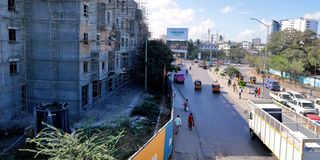Why Kenyans are struggling to lay hands on pension-funded homes

Ongoing construction of affordable housing units at Buxton last week. Homeowners are expecting to be handed over their houses by end of December this year.
Kenya issues an average of 2,226 mortgages per month underlining the housing crisis that has locked out a large section of the population from owning homes despite several State initiatives.
David Ndegwa of Property Dynamics says one of the biggest impediments to owning houses is financing structured to meet the needs of the rich leaving behind a huge section of the country.
He said for instance while banks issued 26,723 mortgages as of December 2021, saccos dished out 150,000 home loan-related products as they help their members acquire homes along with pension funds.
Ndegwa says the solution lies in targeting pensions and saccos, expanding programmes such as the 40 percent advance of retirement benefits to buy homes as well as alternative financing models such as guarantees and stand-by-letters of credit (SBLC).
“Our best chance to increase mortgage uptake is to target saccos and pension schemes. Because while banks issue only 20,000 mortgages, saccos are issuing 150,000 mortgage loans and home-based products. If affordable housing is to work, it has to focus on saccos and pension,” he said during the Liason Group trustee forum in Diani at the Kenyan coast.
Financial institutions
Mr Ndegwa said Kenya is issuing very few mortgages because they are not affordable for the majority of borrowers.
He said half of the 26,723 mortgages that have been issued are targeted at employers of financial institutions.
The cheapest house in the country retails at about Sh3 million and if you take a mortgage to construct such a house you would be required to pay Sh43,000 a month for 10 years.
Mr Ndegwa said if you rent your investment you are not likely to get Sh10,000 on the unit, which does not make economic sense.
Kenya’s construction sector is also rife with brokers inflating the cost of building materials, which makes construction even more expensive.
“In the construction sector you have to deal with brokers, sand harvesters who buy sand at Sh6,000 and sell at Sh16,000, stone dealers who buy at Sh15 a piece and sell at Sh55, and even water. In whose hands are we safe,” Mr Ndegwa posed.
He said while the government has come up with models such as using part of their retirement savings to buy homes in a bid to stimulate a market for affordable homes this fails in a country where 74 percent earn less than Sh50,000 a month. Most savers can only draw minimal amounts from their pensions, which is not enough to buy even the cheapest unit.
Nearly 80 percent have savings below Sh2 million, about 11 percent have saved up to Sh4 million, and three percent have saved up to Sh7 million. Only four percent of savers have put away more than Sh7 million.
“With Sh400,000 you cannot buy any house what you can do is use that as an advance, get a developer to build you a house, and a bank to issue an SBLC as a guarantee at about two percent rather than an expensive loan,” he said.
Kenyans are showing interest in the pension-backed mortgage concept despite many challenges including the tedious application process, high taxes on withdrawals, and caveats on the title that limit the disposal of the house once purchased.
Pension funds also say the law envisioned the houses could only be bought from institutions, which have hampered uptake in rural areas where homes on sale mostly belong to individuals.
“We have received less than 20 applications at the retail level meaning they come directly to us, me being one of them. However, the process is very complicated and tends to discourage home buyers,” Michael Mitau, group head of pension Liason Group, said.
“It is easier for me since I am an insider and know all the requirements needed but in the case of someone on the street he would not know that the house would need to have a certificate of occupation for instance. We need a way to get people to know the mechanics of the application process,” he said.
The Liason Group head of pension says they are trying to sensitise pension trustees to encourage uptake and clarify grey areas around the process of applications.
They hope to discourage pension funds from making it harder for homeowners to get approvals as a way of defending their schemes from losing assets and being open to helping their members acquire homes.
Pension funds were wary that the law would spark outflows bleeding the Sh1.5 trillion savings in schemes.
He said the uptake has also been slow due to the fact the withdrawal attracts a tax charge that puts off potential homeowners.
“We are lobbying to have the tax regime reviewed. I think a lot of clients are discouraged when they hear that the Sh400,000 will not be Sh400,000 but will attract a tax charge,” said Mr Mitau.
Mortgage penetration in Kenya has been poor with the number of mortgage accounts standing at 26,723 as of December 2021.
Sh245.1 billion
Central Bank of Kenya (CBK) data shows that outstanding mortgages totalled Sh245.1 billion by December 2021, up by Sh12.4 billion during the year.
The government wants to stimulate the market through several real interventions including offering banks long-term cheap financing through Kenya Mortgage Refinance Company for onward lending at single-digit rates.
Kenya has also issued developers incentives to trigger the construction of affordable housing.
To stimulate demand, the government introduced a provision allowing pensioners to use 60 percent of their savings as guarantees to access mortgages.
The move failed to attract much interest with lenders showing little enthusiasm in taking up the guarantees. RBA says less than 0.1 percent of members of retirement benefits schemes took advantage of the provision.
The Treasury then changed the law to allow pensioners access to 40 percent of savings towards the purchase of their residential homes.
Members could access savings up to a maximum Sh7 million in a bid to safeguard pension schemes against cash flow challenges.
Pension scheme trustees say the process is also long and tedious requiring a lot of documentation to buy the house.
The housing unit is also encumbered, meaning the owner cannot dispose of the property once bought through the pension advance.
The advance cannot also be used to cover stamp duty and legal fees, which means buyers will need additional resources to make the purchase.





